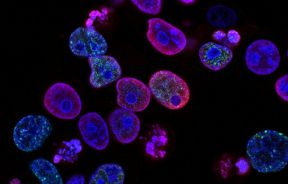Smell Receptors Found Not Only In Nose But In Heart, Lungs, Bloodstream

Though lacking what others possess of the olfactory sense, our human species may have sensory talents hidden throughout the body, including a cellular ability to "smell."
Receptors for smell are located not only on the mucus-covered olfactory epithelium in the back of the nose but in the heart, lungs, bloodstream and other cells of the body, researchers reported Sunday at the 245th annual meeting of the American Chemical Society.
The discovery begs the question of whether the heart or other organs might "smell" artery clogging sirloin on the grill or fresh fruit hanging from a tree. And what grand cellular purpose might these receptors serve?
Peter Schieberle, director for food chemistry at the Technical University of Munich, said the discovery dispels the notion such receptors exist only in the nose, where the cells connect with airborne chemical compounds triggering a biochemical reaction that causes the brain to perceive odor.
"Our team recently discovered that blood cells - not only cells in the nose - have odorant receptors," said Schieberle. "In the nose, these so-called receptors sense substances called odorants and translate them into an aroma that we interpret as pleasing or not pleasing in the brain. But surprisingly, there is growing evidence that also the heart, the lungs and many other non-olfactory organs have these receptors.
Schieberle called the discovery "surprising" and said scientists had no idea why it would be. "Once odor components are inside the body, however, it is unclear whether they are functioning in the same way as they do in the nose," he said, "but we would like to find out."
The five traditional senses and other imbued to some in the animal kingdom remain mysterious in many ways, with some animals able to detect the world in ways we cannot, sensing polarized light and electrical and magnetic fields, underwater pressure and currents in the ocean. Schieberle and his colleagues work in a field called "sensomics," endeavoring to understand precisely how the mouth and nose sense odor, taste and the texture of compounds in foods, particularly in so-called comfort foods like chocolate and roasted coffee.
"Receptors help us sense flavors and aromas in the mouth and nose," said Schieberle. "These receptors are called G-protein-coupled receptors, and they were the topic of the Nobel Prize in Chemistry in 2012. They translate these sensations into a perception in the brain telling us about the qualities of a food."
The smell receptors of the nose are called G-protein-coupled receptors, of which there are 800 or so - in comparison to 27 similar receptors for the sense of taste. Schieberle and others in the field are working to discover why and how the nose - and perhaps other organs - finds certain odors pleasant or repelling and, of course, how they relate to other senses.
Published by Medicaldaily.com



























